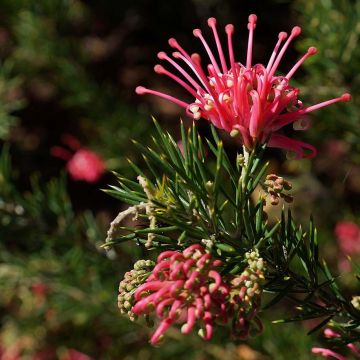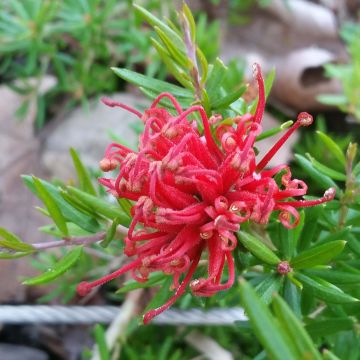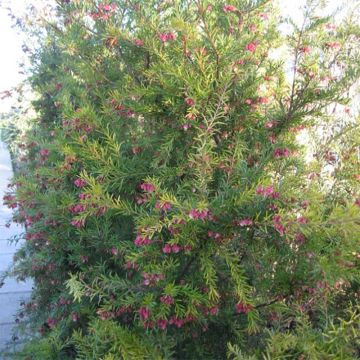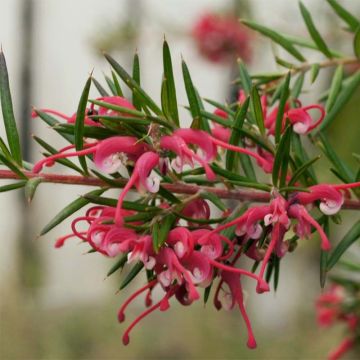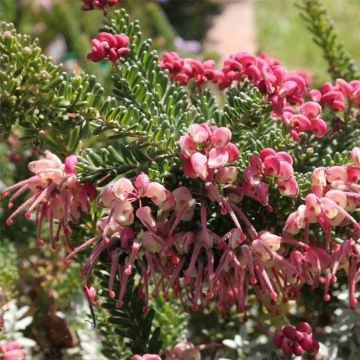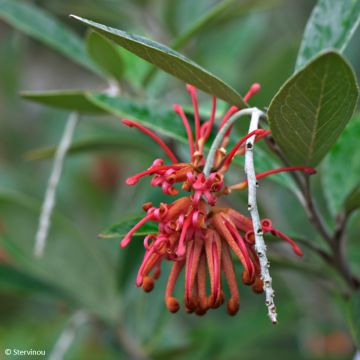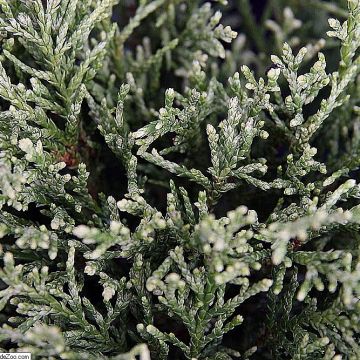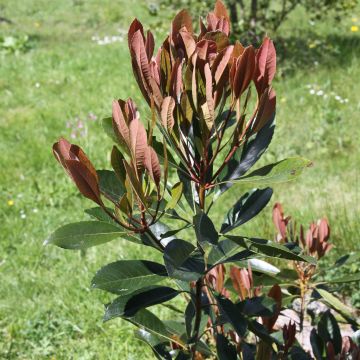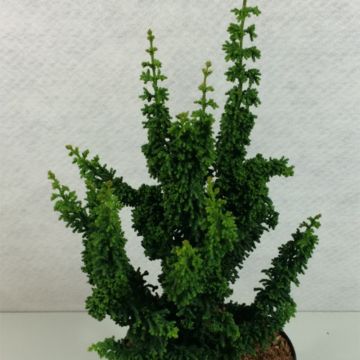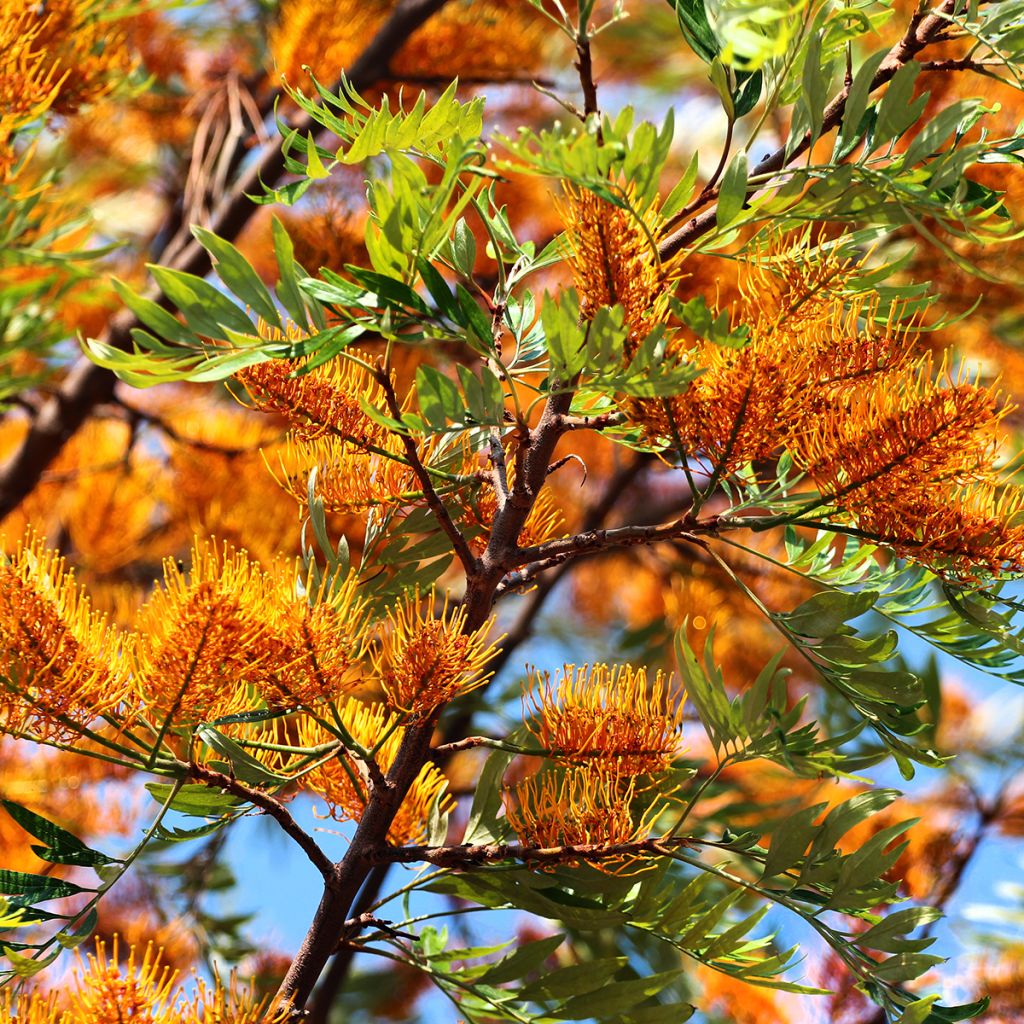

Grevillea robusta - Grévillier
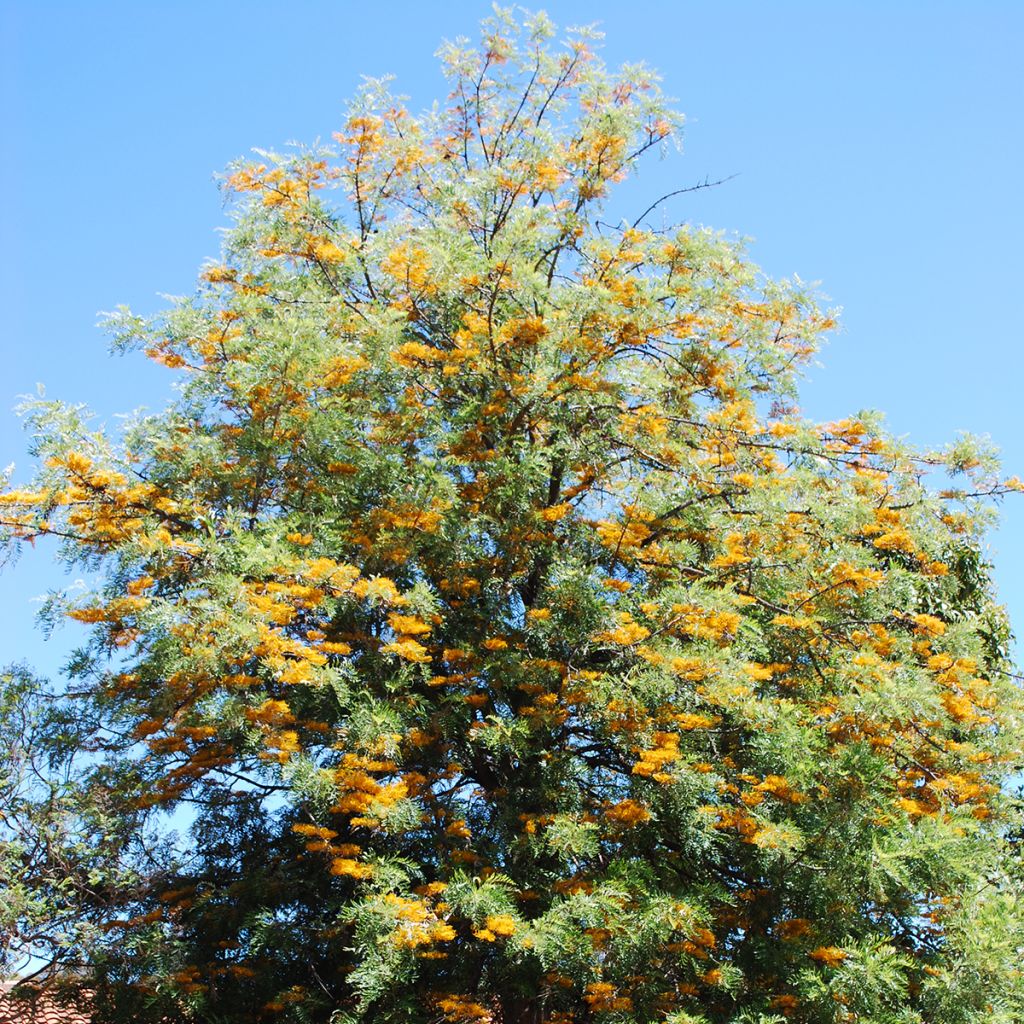

Grevillea robusta - Grévillier


Grevillea robusta - Grévillier
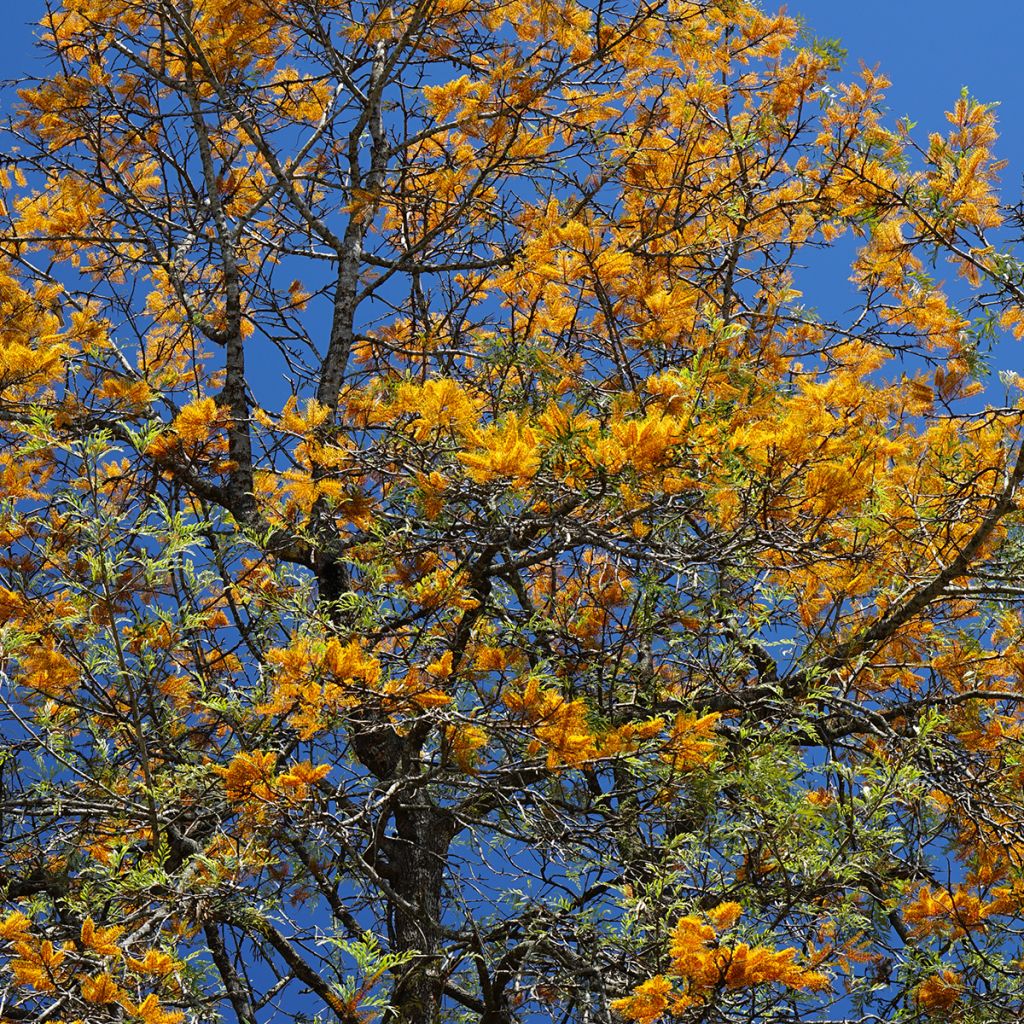

Grevillea robusta - Grévillier
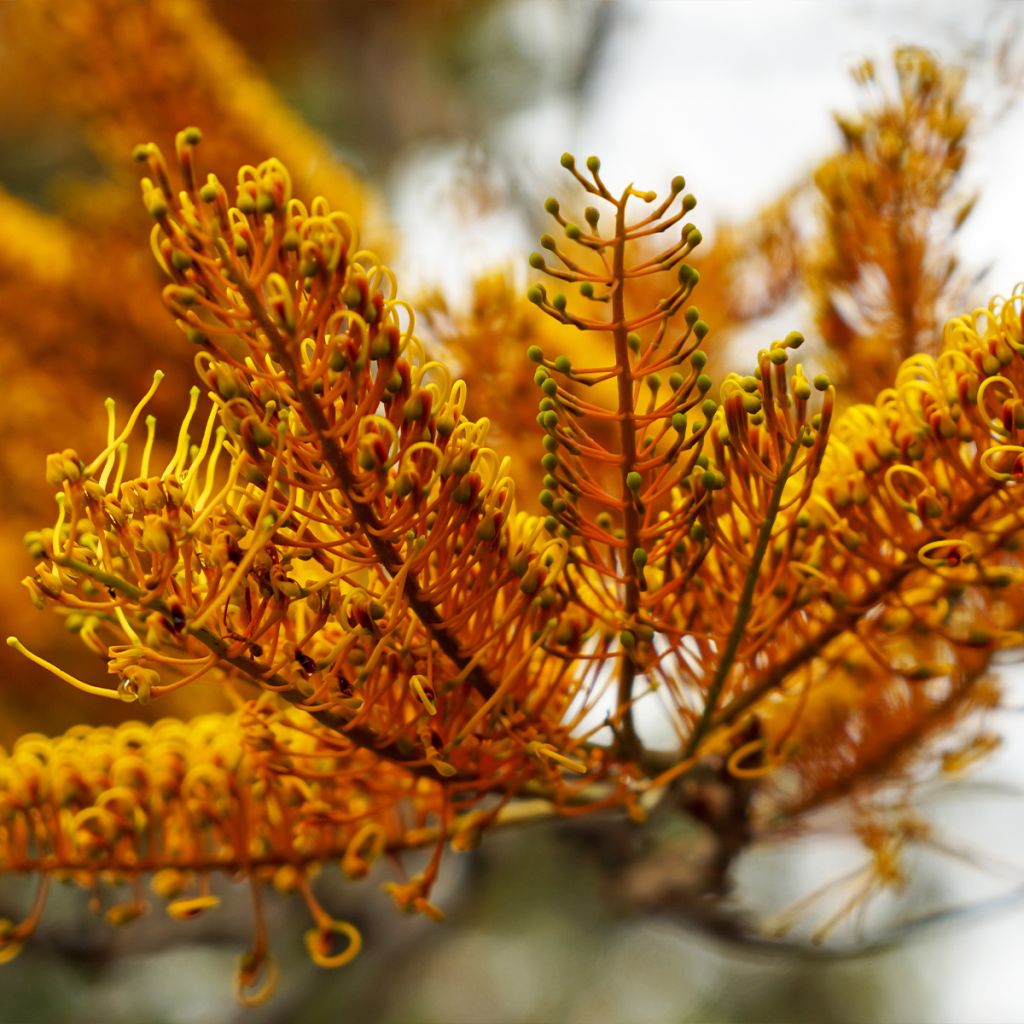

Grevillea robusta - Grévillier


Grevillea robusta - Grévillier


Grevillea robusta - Grévillier
Grevillea robusta
Grevillea robusta
Silky Oak, Southern Silky Oak, Australian Silver Oak
This tree has extraordinary leaves that resemble ferns. It shoots up very quickly without any problem.
Lantana, 24/08/2023
Why not try an alternative variety in stock?
View all →This plant carries a 24 months recovery warranty
More information
We guarantee the quality of our plants for a full growing cycle, and will replace at our expense any plant that fails to recover under normal climatic and planting conditions.
Oversize package: home delivery by special carrier from €6.90 per order..
Express home delivery from €8.90.
Does this plant fit my garden?
Set up your Plantfit profile →
Description
Grevillea robusta, nicknamed the Silky Oak of Australia, reaches impressive dimensions in its country of origin. In gardens, its growth will be less, giving a medium-sized tree with a pyramidal habit. It is very ornamental with its more or less evergreen, deeply cut foliage with a silvery underside and blooms magnificently in spring. Long elongated clusters appear, composed of numerous geometrically arranged yellow-orange flowers. These inflorescences further enhance the tropical appearance of this fast-growing tree. A superb, tender plant, perfect for creating a typical exotic scene.
Grevillea robusta is a tree from the Proteaceae family, which includes 83 genera with some of the most beautiful flowerings in the world (Banksia, Telopea, Protea...). The robusta species is the largest in the Grevillea genus. In Australia, it grows in Queensland and New South Wales, in a subtropical and temperate climate, from coastal areas up to an altitude of about 1100 m (3608 ft 11 in). In the rainforests of these regions, it commonly exceeds 30 m (98 ft 5 in) in height. From the mid-19th century, it began to be planted in many countries with a favourable climate, in other continents: America, Asia, Africa... and in France on the French Riviera, which offers it both the sunshine it needs and sufficiently mild winters.
On the Mediterranean coast, on the southeast side, it forms a medium-sized tree with a distinctly pyramidal habit in the early years. Then, it can expand in a more or less irregular manner, while its height exceeds 10 m, and can even reach up to 15 m (49 ft 2 in) with a width of 6 or 7 m (19 ft 8 in or 23 ft). Its generally straight trunk has a dark, highly veined bark. It supports dense vegetation, highly branched in all directions, forming a dark green mass of foliage. The leaves are extremely architectural. Their leaf is deeply cut, notched up to the central vein, as if they were composed of leaflets themselves again cut. Measuring 15 to 30 cm (5.9 to 11.8 in) long, olive green to dark green in colour, their undersides are silver-grey. Evergreen if the frost is not pronounced, they are decorative all year round, giving this tree an unmatched grace.
From May onwards, long flower clusters measuring up to 15 cm (5.9 in) long appear. These racemes are composed of small flowers, of which the delicately arched, protuberant, yellow-orange stigmas are particularly admired. Their geometric arrangement gives the impression of a hairbrush, confirming this tree belongs to the Proteaceae family, whose flowerings are often graphic masterpieces. This singular, abundant and nectar-rich flowering extends over several weeks, further enhancing the exotic aspect of this Grevillea. Unlike other Proteaceae, highly demanding in terms of soil, this one is relatively accommodating in terms of soil. Hardy down to about -6°C (21.2 °F), or even down to -8°C (17.6 °F) at its coldest for a mature specimen, it does not appreciate cold winds and should therefore be planted in a protected position, exposed to the sun.
Grevillea robusta, with its quick growth, will be the centrepiece of an exotic bed in very sunny coastal gardens. Other Austral plants such as Callistemons, these famous bottlebrushes whose flowers resemble bottle brushes, can be planted alongside it. Whether they are red, pink, white or violet depending on the species, their spectacular inflorescences will rival the beauty of those of the Grevillea. Another Australian shrub, Leptospermum scoparium Martini with its multitude of single pink flowers, will have a place in this bed. You can also try other Proteas such as Leucospermum Copper Carnival, a superb variety with large yellow flowers from this mythical genus, prized by collectors but difficult to cultivate...
Report an error about the product description
Plant habit
Flowering
Foliage
Botanical data
Grevillea
robusta
Proteaceae
Silky Oak, Southern Silky Oak, Australian Silver Oak
Australia
Other Grevillea
Planting and care
Grevillea robusta is best planted in spring, after the last frosts. It is a species that is not very hardy, up to around -5/-6°C, although some well-established and sheltered plants have been able to withstand temperatures of around -8°C. It prefers soil with a pH ranging from acid to neutral, sandy, gritty, poor, and very well-drained. This species also tolerates slightly chalky soils, but the excessive presence of active limestone in the soil causes leaf yellowing (chlorosis). Given the large dimensions of the mature plant, it is unrealistic to hope to permanently contain it in a pit filled with acidic compost if your soil is too chalky. Instead, opt for plants that are better adapted to these conditions. Its deep root system allows it to withstand summer drought once well established.
Choose a sunny location and relatively sheltered from the wind. Dig a large hole (70 or 80 cm (27.6 or 31.5 in) wide and deep) and add planting compost (with a pH around 6) mixed with the existing soil. Since this species does not like compacted soils, this will help lighten it. Regularly water for the first two years until the Grevillea is well rooted. After that, it will show good resistance to dry conditions, requiring only occasional watering during long periods of drought.
Planting period
Intended location
Care
-
, onOrder confirmed
Reply from on Promesse de fleurs
Evergreen shrubs
Haven't found what you were looking for?
Hardiness is the lowest winter temperature a plant can endure without suffering serious damage or even dying. However, hardiness is affected by location (a sheltered area, such as a patio), protection (winter cover) and soil type (hardiness is improved by well-drained soil).

Photo Sharing Terms & Conditions
In order to encourage gardeners to interact and share their experiences, Promesse de fleurs offers various media enabling content to be uploaded onto its Site - in particular via the ‘Photo sharing’ module.
The User agrees to refrain from:
- Posting any content that is illegal, prejudicial, insulting, racist, inciteful to hatred, revisionist, contrary to public decency, that infringes on privacy or on the privacy rights of third parties, in particular the publicity rights of persons and goods, intellectual property rights, or the right to privacy.
- Submitting content on behalf of a third party;
- Impersonate the identity of a third party and/or publish any personal information about a third party;
In general, the User undertakes to refrain from any unethical behaviour.
All Content (in particular text, comments, files, images, photos, videos, creative works, etc.), which may be subject to property or intellectual property rights, image or other private rights, shall remain the property of the User, subject to the limited rights granted by the terms of the licence granted by Promesse de fleurs as stated below. Users are at liberty to publish or not to publish such Content on the Site, notably via the ‘Photo Sharing’ facility, and accept that this Content shall be made public and freely accessible, notably on the Internet.
Users further acknowledge, undertake to have ,and guarantee that they hold all necessary rights and permissions to publish such material on the Site, in particular with regard to the legislation in force pertaining to any privacy, property, intellectual property, image, or contractual rights, or rights of any other nature. By publishing such Content on the Site, Users acknowledge accepting full liability as publishers of the Content within the meaning of the law, and grant Promesse de fleurs, free of charge, an inclusive, worldwide licence for the said Content for the entire duration of its publication, including all reproduction, representation, up/downloading, displaying, performing, transmission, and storage rights.
Users also grant permission for their name to be linked to the Content and accept that this link may not always be made available.
By engaging in posting material, Users consent to their Content becoming automatically accessible on the Internet, in particular on other sites and/or blogs and/or web pages of the Promesse de fleurs site, including in particular social pages and the Promesse de fleurs catalogue.
Users may secure the removal of entrusted content free of charge by issuing a simple request via our contact form.
The flowering period indicated on our website applies to countries and regions located in USDA zone 8 (France, the United Kingdom, Ireland, the Netherlands, etc.)
It will vary according to where you live:
- In zones 9 to 10 (Italy, Spain, Greece, etc.), flowering will occur about 2 to 4 weeks earlier.
- In zones 6 to 7 (Germany, Poland, Slovenia, and lower mountainous regions), flowering will be delayed by 2 to 3 weeks.
- In zone 5 (Central Europe, Scandinavia), blooming will be delayed by 3 to 5 weeks.
In temperate climates, pruning of spring-flowering shrubs (forsythia, spireas, etc.) should be done just after flowering.
Pruning of summer-flowering shrubs (Indian Lilac, Perovskia, etc.) can be done in winter or spring.
In cold regions as well as with frost-sensitive plants, avoid pruning too early when severe frosts may still occur.
The planting period indicated on our website applies to countries and regions located in USDA zone 8 (France, United Kingdom, Ireland, Netherlands).
It will vary according to where you live:
- In Mediterranean zones (Marseille, Madrid, Milan, etc.), autumn and winter are the best planting periods.
- In continental zones (Strasbourg, Munich, Vienna, etc.), delay planting by 2 to 3 weeks in spring and bring it forward by 2 to 4 weeks in autumn.
- In mountainous regions (the Alps, Pyrenees, Carpathians, etc.), it is best to plant in late spring (May-June) or late summer (August-September).
The harvesting period indicated on our website applies to countries and regions in USDA zone 8 (France, England, Ireland, the Netherlands).
In colder areas (Scandinavia, Poland, Austria...) fruit and vegetable harvests are likely to be delayed by 3-4 weeks.
In warmer areas (Italy, Spain, Greece, etc.), harvesting will probably take place earlier, depending on weather conditions.
The sowing periods indicated on our website apply to countries and regions within USDA Zone 8 (France, UK, Ireland, Netherlands).
In colder areas (Scandinavia, Poland, Austria...), delay any outdoor sowing by 3-4 weeks, or sow under glass.
In warmer climes (Italy, Spain, Greece, etc.), bring outdoor sowing forward by a few weeks.

































